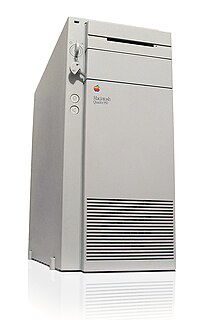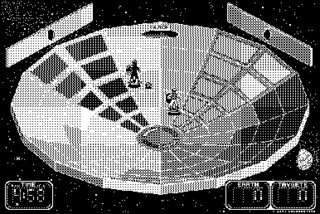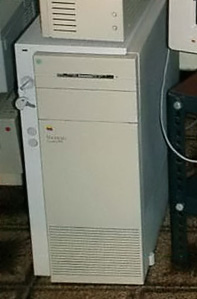
The Macintosh Classic is a personal computer designed, manufactured and sold by Apple Computer, Inc. from October 1990 to September 1992. It was the first Macintosh to sell for less than US$1,000.

The Macintosh IIci is a personal computer designed, manufactured, and sold by Apple Computer, Inc. from September 1989 to February 1993. It is a more powerful version of the Macintosh IIcx, released earlier that year, and shares the same compact case design. With three expansion slots, the IIci improved upon the IIcx's 16 MHz Motorola 68030 CPU and 68882 FPU, replacing them with 25 MHz versions of these chips.

AppleWorks is an integrated office suite developed by Rupert Lissner for Apple Computer, originally for the Apple II platform, and released in 1984. The program contains a word processor, database, and spreadsheet.

The KoalaPad is a graphics tablet produced from 1983 by U.S. company Koala Technologies for the Apple II, TRS-80 Color Computer, Atari 8-bit family, and Commodore 64, as well as for the IBM PC.
GraphicConverter is computer software that displays and edits raster graphics files. It also converts files between different formats. For example, one can convert a GIF file to a JPEG file.
Spiderweb Software is an independent video game developer founded in 1994 by Jeff Vogel in Seattle, Washington. Its primary focus is on creating demoware games for the Apple Macintosh, Microsoft Windows, Android and the iPad. Spiderweb Software is also known for emphasizing storytelling and turn-based gameplay and using a retro style of graphics.

The Macintosh IIcx is a personal computer designed, manufactured and sold by Apple Computer, Inc. from March 1989 to March 1991. Introduced half a year after the Macintosh IIx, the IIcx resembles the IIx to a great extent and provides the same performance, but is seven inches narrower, ten pounds lighter, and somewhat quieter due to a smaller internal fan. The relative compactness results in three NuBus slots being available, compared with six on the IIx. The new case, Apple's first to be designed to operate in either a horizontal or vertical orientation, remained in use for its successors the Macintosh IIci and Quadra 700. The idea for vertical orientation, one of the first minitower cases, was suggested by Apple CEO John Sculley, who was running out of space on his desk, despite the fact that the new layout actually took more space once the monitor was taken into account. The model was designated IIcx for compact, and the x was Apple's designation for the 68030 processor.
Digital painting is an emerging art form in which traditional painting techniques such as watercolor, oils, impasto, etc. are applied using digital tools by means of a computer, a digitizing tablet and stylus, and software. Traditional painting is painting with a physical medium as opposed to a more modern style like digital. Digital painting differs from other forms of digital art, particularly computer-generated art, in that it does not involve the computer rendering from a model. The artist uses painting techniques to create the digital painting directly on the computer. All digital painting programs try to mimic the use of physical media through various brushes and paint effects. Included in many programs are brushes that are digitally styled to represent the traditional style like oils, acrylics, pastels, charcoal, pen and even media such as airbrushing. There are also certain effects unique to each type of digital paint which portray the realistic effects of say watercolor on a digital 'watercolor' painting. In most digital painting programs, the users can create their own brush style using a combination of texture and shape. This ability is very important in bridging the gap between traditional and digital painting.
The Print Shop is a basic desktop publishing software package originally published in 1984 by Brøderbund. It was unique in that it provided libraries of clip-art and templates through a simple interface to build signs, posters and banners with household dot-matrix printers. Over the years the software has been updated to accommodate changing file formats and printer technologies.

The Macintosh Quadra 950 is a personal computer designed, manufactured and sold by Apple Computer, Inc. from March 1992 to October 1995. It replaced the Quadra 900 that was introduced several months earlier, increasing the CPU clock rate of its 68040 CPU from 25 MHz to 33 MHz, and improving the graphics support. The two computers were otherwise identical, including the price. With a Macintosh Processor Upgrade Card installed, this computer is known as the Power Macintosh 950.

The Macintosh Quadra 700 is a personal computer designed, manufactured and sold by Apple Computer, Inc. from October 1991 to March 1993. It was introduced alongside the Quadra 900 as the first computers in the Quadra series using Motorola 68040 processor. It is also the first computer from Apple to be housed in a mini-tower form factor, which in 1991 was becoming a popular alternative to standard desktop-on-monitor cases that were common through the 1980s.
Raster graphics editors can be compared by many variables, including availability.

The Macintosh LC III is a personal computer designed, manufactured, and sold by Apple Computer, Inc. from February 1993 to February 1994. It replaced the commercially successful Macintosh LC II in Apple's lineup of mid-range computers, and was significantly faster, with MacWorld Magazine benchmarks showing 2x performance in all major categories - CPU, disk, video and math. It was also significantly less expensive; the LC III with an 80 MB hard disk was priced at $1,349 USD at introduction, $700 less than the LC II. The LC III was sold primarily to educational institutions, and a corresponding Performa variant called the Performa 450 was sold to the consumer market.

Pararena is an action computer game for the Apple Macintosh computer originally written in 1990 by John Calhoun and released as shareware. Calhoun previously wrote the Macintosh game Glider.

The Macintosh Quadra 900 is a personal computer designed, manufactured, and sold by Apple Computer, Inc. from October 1991 to May 1992. It was introduced alongside the Quadra 700 as the first computers in the Quadra family of Macintosh computers using the Motorola 68040 processor. It is also the first computer from Apple to be housed in an 18.6 inch tall mid-tower form factor, which by 1991 had gained momentum with PC manufacturers as a suitable design for departmental servers.
PC Paintbrush is graphics editing software created by the ZSoft Corporation in 1984 for computers running the MS-DOS operating system.

PCPaint was the first IBM PC-based mouse-driven GUI paint program. It was developed by John Bridges and Doug Wolfgram. It was later developed into Pictor Paint.

Info-Mac is an online community, news aggregator and shareware file hosting service covering Apple Inc. products, including the iPhone, iPod and especially the Macintosh. Established in 1984 as an electronic mailing list, Info-Mac is notable as being the first online community for Apple's then-new Macintosh computer. Info-Mac was the dominant Internet resource for Mac OS software and community-based support throughout the 1980s and early 1990s.

The Macintosh is a family of personal computers designed, manufactured, and sold by Apple Inc. since January 1984. The original Macintosh was the first mass-market personal computer that featured a graphical user interface, built-in screen and mouse. Apple sold the Macintosh alongside its popular Apple II family of computers for almost ten years before they were discontinued in 1993.













